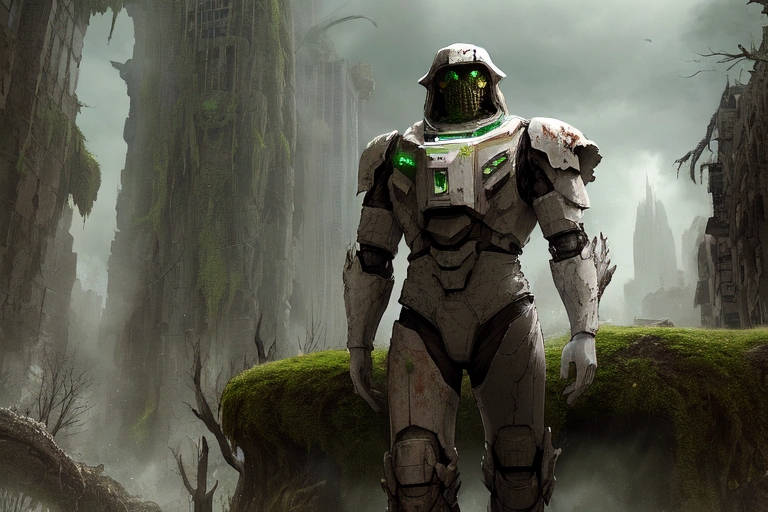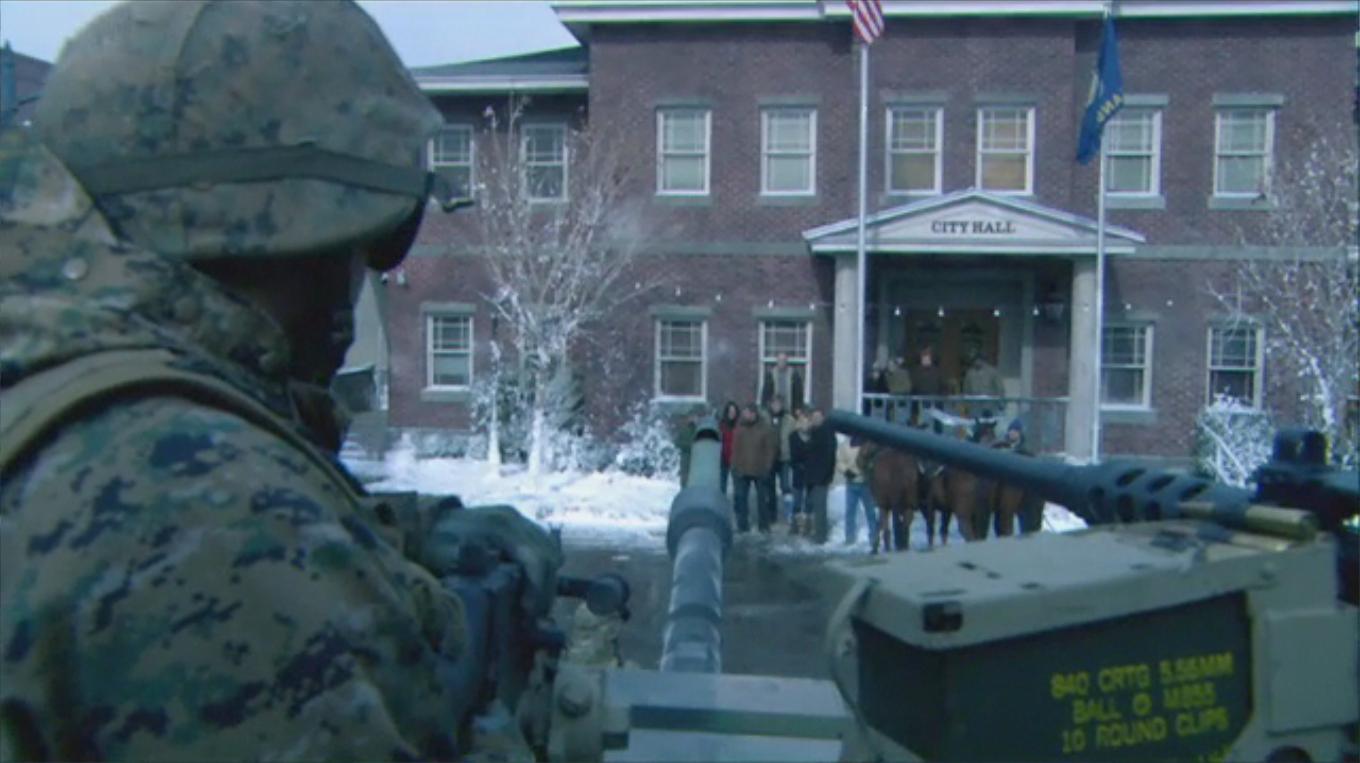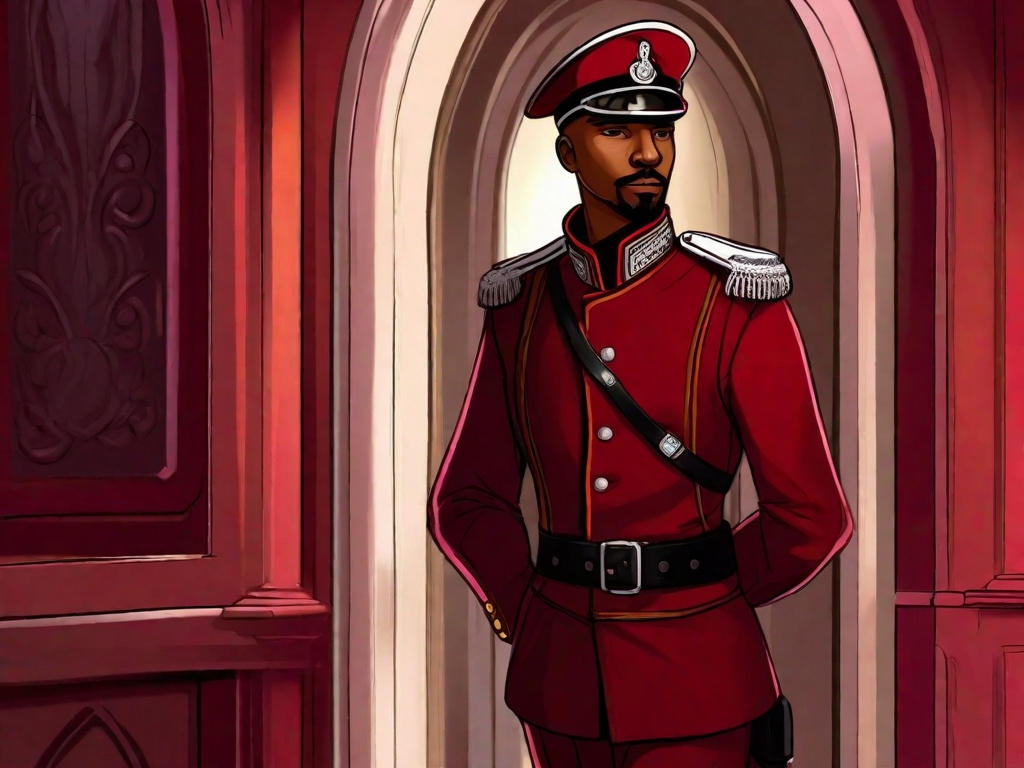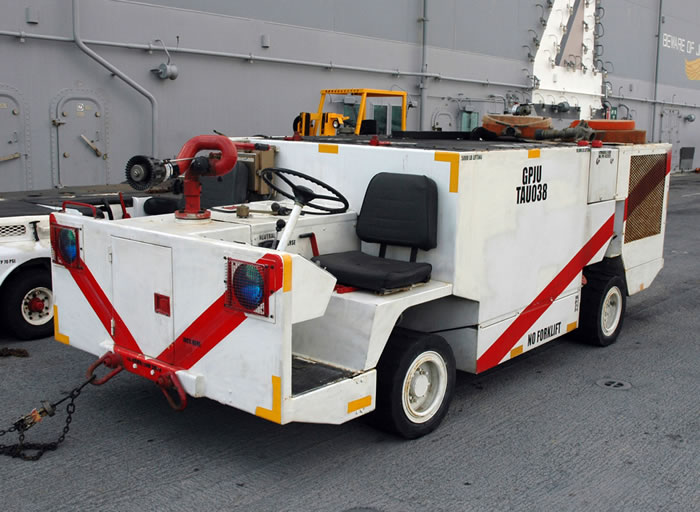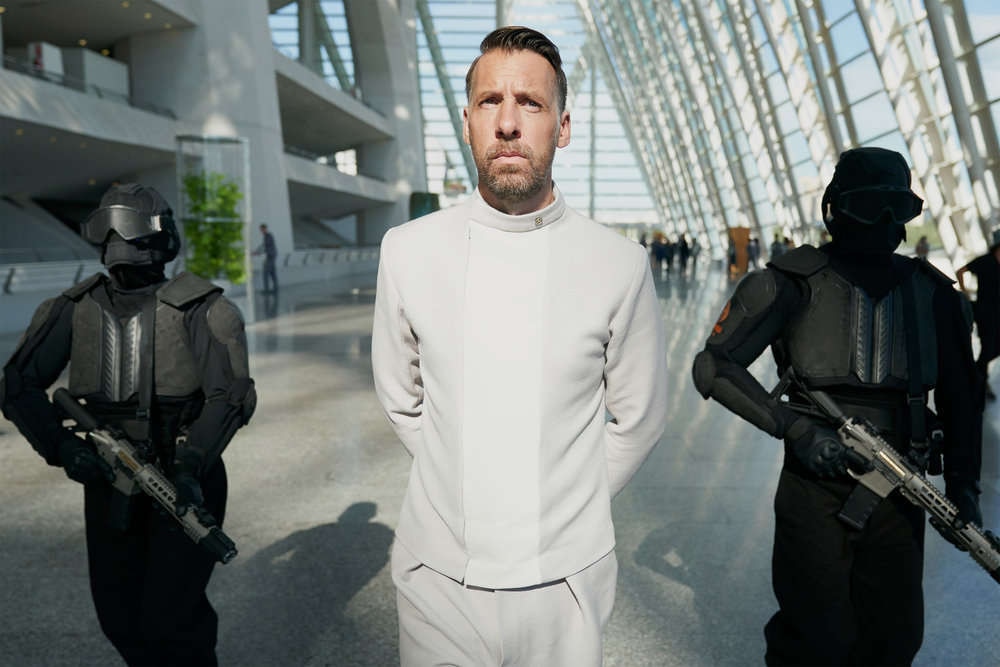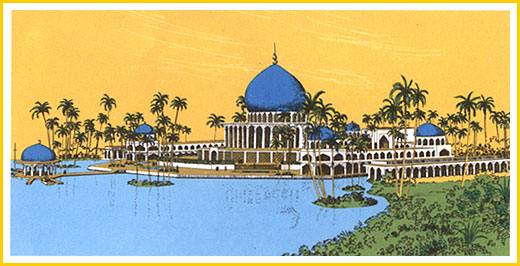The Governor’s Gate was the ARC-built western entrance to Fort Quileute, inaugurating the third anniversary of Recontact. Its subsurface arboretum featured gengineered water-efficient trees that each consumed forty liters a day
Recontact with the New Two Thousand transformed Fort Quileute. As Pilgrim trade caravans made the long trek across the sands to the jewel of the Great Dunes, the mission decades of alien artifact searching and harvesting finally yielded economic dividends. The base became a major hub in the xenoartifact trade, bringing visitors from across the known world. The ARC
Moon Over Parma, the Pilgrims’ experimental cargo airship, paid a visit to the desert rose, docking at the minaret of the Golden Shah Mosque to bring forth stores of seedstock, solar panels, and seafood. It took back crates upon crates of artifacts discovered buried beneath the sands. Many were still functional, never connected to the Fort’s pseudonode. At Terra Nova,
civilization, their secrets would be properly exploited to unlock technical knowledge, or sold for very profitable sums on the antiquities market.
Reunited with its faction, the Director's Council solicited investment to build paved highways and trade depots, garages full of rovers and rudimentary ‘chopper pads. As development funds poured in, the base next constructed lodgings for traders; a hologram theater, a MindMaze dreamhouse, and an entertainment center to amuse weary travelers; and a huge shopping complex that cast a shadow over the Grand Medina between the hours of 10:00 and 12:00 in the mid-afternoon. Fort Quileute had found an industry, its place in the Planetary economy, and it would milk it as long as the Great Dunes had treasures for sale.
John Adams said:
I could fill Volumes with Descriptions of Temples and Palaces, Paintings, Sculptures, Tapestry, Porcelaine, &c. &c. &c. -- if I could have time. But I could not do this without neglecting my duty. - The Science of Government it is my Duty to study, more than all other Sciences: the Art of Legislation and Administration and Negotiation, ought to take Place, indeed to exclude in a manner all other Arts. I must study Politicks and War that my sons may have liberty to study Mathematicks and Philosophy. My sons ought to study Mathematicks and Philosophy, Geography, natural History, Naval Architecture, navigation, Commerce and Agriculture, in order to give their Children a right to study Painting, Poetry, Musick, Architecture, Statuary, Tapestry and Porcelaine. - Letter to Abigail Adams (12 May 1780),
Datalinks
A recreational psychonaut visits old Jerusalem and the Holy Land at the Seven Sleepers Dreamplex, built during the Recontact years
Firyal Kašk and her husband gradually retired from public service to focus on their growing family. Their eldest, Nasum, received an upbringing quite unlike their own- far from the traumas of repression, exile, and frontier toil, the boy grew up in the rapidly increasing quality of life that came with the Governor’s patronage of the base. Luxuries unimaginable only several mission years ago were suddenly within a caravan’s reach. Children’s clothing were no longer made of re-stitched
Unity uniforms or of the clothing of the deceased, spun from Egyptian cotton only for the wealthiest scions of the colony. Aerogel fashions from Terra Nova’s consumer-facing factories upended the native textiles industry of the base.
The local food diversity quadrupled overnight as Pilgrim caravans and ARC supply runs brought forth fruits, vegetables, and grains lost to the colony’s agriculturalists, a cornucopia compared to the enriched but bland nutrient resources tapped from the monoliths of the desert. Young Nasum and his siblings grew up running through new orchards of Jaffa oranges and McIntosh apples in the fresh fruit parks that adorned the base’s green belt, destination of tourists and local poets alike. The reintroduction of the coffee plant fueled a cultural renaissance within a renaissance as cafés sprang forth like toadstools after rain. Caffeinated hookah with a coffee fruit extract base added jolt to relaxation, quickly becoming the default vice for elderly retirees and idlers. In his youth, Nasum himself became a frequenter of the hookah lounges, listening to the tales of the bad old days from the grizzled ex-scouts and laborers who had surveyed the burning seas and built the society from under the noses of the ARC Directors.
Sophia Al-Maria said:
Sueraya Shaheen: You explore the shopping mall as a destination.
Al-Maria: That’s certainly an environment. It’s the future. It’s time travel that you went through, and it’s the end of the world. It’s even after the end of the world, when there’s a few ghosts of people left, people that you are not able to identify with blurred faces. The work shows the shopping mall as the haunted house. It’s frightening but it also has that deliciously scary feeling to it.
-
Vogue Arabia interview,
Datalinks
Skipping Jumu’ah
prayer, a lazing shopper stretches in the main entrance of the Forty Thieves Commercial Plaza
Even as Recontact satiated the basic material needs of the frontier base, it also sought to enrich the cultural, even spiritual lives of its inhabitants. Nasum was the first generation of Fort Quileute to grow up with new toys instead of those recycled from the earliest days of the Stellar Lifeboat Project, carved from desert stone or scarab-snake shell. Gone were the days of simple dolls and figurines adorned in traditional garb stitched together from rags. Now were miniature robots that could sing, dance, answer homework questions, and beam holographic images onto every surface. They were joined by their elder sibling servitors, household robotics of every type that the Pilgrims had secured from the
Unity or bought from the Morganites and the Children, making sweeping the Hab Complex and harvest season in the Agridome a thing of the distant past.
But most of all, the colony received widespread consumer tech, from optical datalinks to ClipCom devices, each a far cry from the quicklinks sleeve computers left over from vintage
Unity uniforms. Each plugged the user directly into the datalinks, a world hitherto unknown to the Al Falah host. Suddenly, the desert seemed a lot smaller as news of faraway biomes and vendettas between unfamiliar peoples, entire factions’ worth of cultural creations, athletics and recreational games invented post-Planetfall, all became within grasp, making the endless sands a little more finite. Places to yearn to visit, if not to one day relocate to, entirely.
The clans that once safeguarded the former exiles of the Stellar Lifeboat Project no longer seemed as relevant. The rich oral histories that once thrived in the absence of mass media seemed quaint. The youth of the base, bored to tears by the conservative thrift of their survivor ancestors, drifted out into the Commercial Plaza and other ARC-oriented amenities to stare mindlessly at soap operas and sports programs displayed in electronics departments, sneaking into alcohol-vending cantinas.
Sammy Abdullahi said:
You see that nice, juicy number on the bottom? That's your golden parachute. Drape it behind your pleasure foil, make the top-tals at the cabana club jealous. Fly a hot air balloon over the Uranium Flats, jump out, wave 'hi' to Chairman Groundhog, whatever you like. But know this is the payout you forgo if you reject acquisition. You walk, and I guarantee you so many Pilgrim gentry fungs will come crawling with their field hands, you'll think you built this little trade post on Plymouth Rock. - transcript from the Annexation of Echo Factory, formerly Morgan Rarities
Burgemeester
Sammy Abdullahi was the Governor's eyes and ears in Fort Quileute, the face of ARC during Recontact
In contrast to the
carte blanche that the overwhelmed Council had once granted the citizenry of the base, reintegration with mother faction meant more than minimal oversight. But while van de Graaf's natural move would have been to send one of his tough-talking mountain man-turned-stakeholder country squires to crack the whip and ensure the cattle trains ran on time, his CFO-CHIO pursued a different tactic. Fielding chose one of her fixer-operators from one of the New Two Thousand's few urbanized centers to serve as the unlikely magistrate of this furthest frontier. Fresh from corporate vendettas and financial destabilization campaigns against the faction's business rivals,
Stadtholder Sammy Abdullahi was sent packing from his private energy fund in the New Guilderland financial district, ferried by prototype airship to Fort Quileute.
A third generation Manhattanite whose Farsi was largely acquired via data-wheel, Abdullahi had taken one of ARC's financial services spin-offs and commandeered it into a brokerage of ecological futures, sovereignty swaps, and other complex derivatives that all boiled down to betting against the sunrise. Taken to Centauri to recreate an economic system with all of the last planet's trapdoors, backdoors, dirty tricks built in from the start, he had advanced the firm's interests against the likes of Morgan and Preston, and oversaw the development of shell companies for proxy battles in the capitalist jungle of the Chiron Cartel. Through overwrought profane skullduggery, the acerbic investor had secured a not-inconsiderable interest in the Ministry of Public Information of the Memory of Earth, successfully prevailing in the courts that his shares of RoyStar Weiguo from Earth were still legally binding in this new biosphere. (The fact a
government institution is subject to the opinions of an outside shareholder, never mind an agent of an occasionally-hostile faction, infuriates Commander Mercator to no end, presenting plenty of nightmarish situations for the hapless Chairman of News Programming Jerry Wobegon and his assistant Donald “Dharma” Vetter.)
The economic probe was to be a judge of the change over the transformation of the base into a legitimate Pilgrim city. As Burgomaster, he was in theory the new governor of the base, a viceroy with full and sweeping powers left completely to his discretion.
Shortly after arriving upon the dusty streets of the fort, Abdullahi skipped out on the elaborate welcoming ceremony hosted by the Director’s Council to sip Arabic coffee, posing as one of the many independent artifact traders who had flocked to the base. After several chats with natives and fellow visitors alike, sampling the local fried
luqma- a notorious gourmand, the Burgomaster was as equally renowned for his sumptuous lavender-draped wine and cheese soirees at Morgan Riviera as he was for stealing one-erg cronuts from Queequeg's Coffee franchises back at NG - he disappeared into the crowds of the medina. Emerging hours later, a case of sweets in one hand, an exquisite
midwakh carved from mindworm husks in the other, he congratulated his bewildered hosts for the marvelous little society they had built. Then, gesturing at the hazy air casting mirages down the hall, opening the box to reveal half of the Turkish delights melted, proceeded to demand the Directors upgrade its environmental control systems immediately. Dazed but dazzled by praise, the former masters of the base immediately ordered improvements to their Closed Habitat Atmospheric Production facility. Thus did air conditioning, built from mission decades' worth of advancements from the rest of Planet, kickstart the viceroy's tenure.
The Alfitr
Towers were built for storing surplus resources reclaimed from Recycling Tanks. The design, an exact replica of the Swedish-built mushroom water towers of Kuwait City, was mandated by the Burgemeester
to attract visitors
The arrival of Burgomaster Abdullahi marked a new stage in the hyper-development of Fort Quileute. The expansion of the mall into a bonafide Commercial Plaza modeled after the Prince Nasir Al-Subaai Supermall in Dammam, the Triplet Cities Emirate, took place under his watch; as did the construction of a massive vehicle bay for housing crawlers bound for the desert. The secondary guest Hab Complex was converted into a two-star luxury hotel in imitation of a Morgan Hilton, which was still far more extravagant than the region had ever seen. A Schreiber Project adventurer-anthropologist at the time described the looks of "mad anticipation" that greeted a troop of Sand Scouts returning from one of their artifact sweeps, beholding the gleaming edifice of the Quileute Continental for the first time. Weatherworn smacers, contracted by the viceroy to assist in the search and disarming of hazardous alien ruins, threw drunken revelries in the ultra-thread count upholstered suites of the hotel, becoming yet another sign of the incongruous progress that characterized the Recontact era. As were the increasingly expanding mega-projects replacing entire sections of the old base.
Burj Al Falah penthouse, high Recontact era
The rejoining of Fort Quileute with the New Two Thousand irrevocably changed the soul of the base as it did its exterior. While posterity would condemn the time as a “generation of weakness,” little surprise that those who were farming moisture from the desert air and gathering crumbs from deep desert monoliths would readily grasp the horn of plenty, when proffered. As the base slowly joined Planetary society, it too would take on familiar problems of drone discontent, datalinks addiction, and ecological destruction.
There were those who disagreed with change. The labor organizer who could not be bought by thirty thousand ¤ a year, the over-pious imam or priest. Movements deemed too recalcitrant or dangerous were identified with pinpoint accuracy and handled by the newly-formed Desert Regulators, largely imported by veterans fresh from vendettas back home. But for the most part, the population of the base was glad to receive the fruits of modernity, regardless of cost.
The Burgomeister had rubbed the right shoulders, paid the occasional visit to mosque, doled out gift boxes of neocoke (he was a casual user- the elites he introduced it to, less so) through the office of the viceroy itself. Over time, the senate of sheiks gradually sold to the advancing ARC authority the same properties they had so fiercely, and perhaps quixotically, protected against the previously-ruling Council. Some who had signed away entire districts under their care could expect to be compensated with sports speeders imported from the capital, racing them through the sands and on the gleaming new highways around the base perimeter. The populace was largely satisfied by Public Antiquities Fund payments even as Terra Nova exported its own set of expert artifact hunters, ruin scavengers, and transporters, leaving the natives with more time for consumption. And the Al Falah Trade Union was happy as it received contract after contract to build yet another hotel, yet another discoveries showroom, yet another monument to factional grandiosity. Firyal Kašk and her husband retired contentedly to care for their brood, confident that the future of the colony was in the right hands. Their son Nasum aspired to be an academic of history, perhaps at the burgeoning university under construction.
Whatever one’s opinion of Recontact is, all agree that it was a Golden Age for the base that sprouted as abruptly as its tragic termination. Remembered not only as a mourned lost age, but recited as a promised glorious future to come.
Casting
Sammy Abdullahi is portrayed by Arian Moayed as Stewy Hosseini in
Succession
Notes
This post was inspired by Gulf Futurism, a term coined by American-Qatari author and artist Sophia Al-Maria and Kuwaiti composer and artist Fatima Al Qadiri to denote an aesthetic marked by the drastic changes brought about by oil wealth to the Persian Gulf states: the rise in consumerism and materialist excess in traditionalist cultures, the drastic increases in wealth inequality, and the authoritarianism involved.
A quick primer on Gulf Futurism from WIRED columnist and cyberpunk founder Bruce Sterling, linking to
“The desert of the unreal”, the original 2012 article where the phrase was first defined.
The ClipCom is a device mentioned in
Outpost 2's
Tales of New Terra
Quicklinks are computers built into a uniform sleeve, linked to other citizens, as described in the “Journey to Centauri” novella by Michael Ely
The fate of the Al Falah youth in the face of the datalinks is taken from the description of the Gaian-esque rustic
Forest Arcology of
Sim City 2000
Introductory scene of
Succession’s Stewy Hosseini, the basis of Sammy Abdullahi
Queequeg's Coffee is from
Deus Ex: Invisible War
CHAP facilities are from
Outpost 1
Prince Nasir, of the Al-Subaai family, is from
Syriana
Image Credits
The opening photo is concept art of Saudi Arabia’s
Neom project, dubbed the Line.
Elevator into the Dome of the Rock is from the short film
Nation Estate (2012) by Larissa Sansour, which imagines what if Palestine's statehood is confined in a high-rise skyscraper, with each city in a floor of its own. (“
Ancient Aliens, Gulf Futurism, and Social Justice: The Liberating Visions of Arab Science Fiction”)
Figure laying on the marble floor is still from Sophia Al-Maria’s
Black Friday exhibit,
Whitney Museum
Kuwait Water Towers photo is by
Al Manlangit
The opulent penthouse is album art of Fatima Al Qadiri’s
Genre-Specific Xperience
Further reading
Al Qadiri & Al-Maria on Gulf Futurism - architectural and media examples of the aesthetic, Dazed Digital
'Gulf Futurism' Is Killing People - real-world repercussions,
VICE Magazine
Ethnic Futurism In The Gulf - a critique of Gulf Futurism, Thesigers
Gulf Futurism: The Future Is Not A Desert Mirage,
Sail Magazine
The Luxury Mall as Consumer Prison, review of Sophia Al-Maria’s “Black Friday”,
New York Times
Gulf Futurism: How Post-Carbon Imaginaries Are Reproducing the Systemic Crisis, Berliner Gazette

